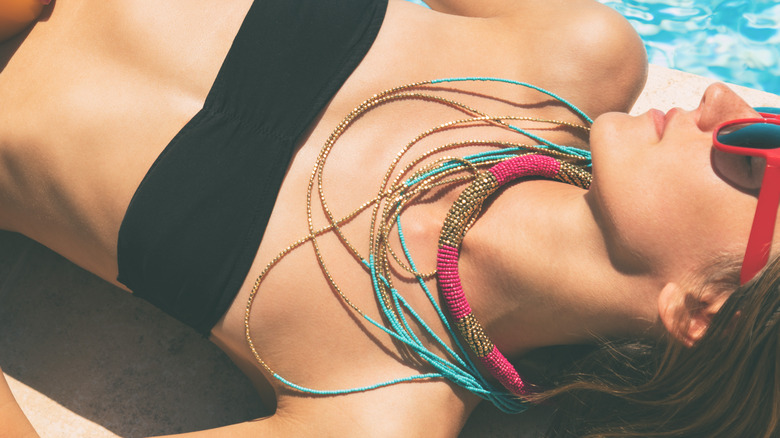Swimming With Jewelry May Look Cute, But Is It A Good Idea?
Although swimming has many perks, it's not without hazards. Hidden-in-plain-sight depth markers, bad lighting, and leg cramps can result in injuries or even drowning. Every tiny, little detail can turn into a life-or-death matter when you're in the water. That's why it's important to know and follow the do's and don'ts at a swimming pool to enhance your safety and minimize accidents.
Of course, how you dress at the pool can affect your safety in it. Dressing appropriate for swimming is more than just putting on a bathing suit that covers all your private parts. It also entails taking off things that can put you in danger, even though they enhance your style — like jewelry.
It's not uncommon to see people take the plunge and dive into water with jewelry on. Maybe they think jewelry is too insignificant to be their Achilles heel in the water. Or they think their jewelry complements their bathing suit and makes them stand out in the pool. No matter the reason, it's not a good idea to wear jewelry into the water. Not only is it inconvenient, but it's also dangerous.
Chlorine can damage your jewelry
Since chlorine is a strong chemical element, it can cause permanent damage to gold and silver jewelry, per Land's End. According to Argo & Lehne Jewelers, the harsh chemicals in chlorine pools can also dull the sheen in your diamond jewelry. If you paid lots of money for your precious stones, don't wear them when swimming to avoid this damage. Unfortunately, salt water can also erode your favorite pieces, so a beach swim isn't much safer. In case you must wear jewelry in the pool, opt for pieces made purely of platinum or palladium since they are less vulnerable to chlorine damage (via Cormiers).
If your jewelry has come into contact with chlorine, rinse it off right away in fresh water without using any harsh cleaning products. When you get home, immerse your jewelry in warm water mixed with dish soap, rinse it under cold water from the faucet, and then dry it with a lint-free cloth. The safest approach to protect your fine jewelry from chlorine damage as well as loss is to take it off, store it securely in a tiny jewelry bag or a ring holder, and only put it back on once you're completely dry.
If your expensive jewelry has been exposed to harsh elements and you don't know how to reverse the damage, bring it to a professional jewelry cleaner. They have the expertise and the tools to help restore its shine and extend its life.
Jewelry can lead to drain entrapment
One of the most common swimming pool accidents is pool suction drain injury, also known as drain entrapment. This occurs when a swimmer's loose hair, jewelry, or body parts get pulled into the drain, or any other pool hole, and are gripped tight until the suction stops. Not only can drain entrapment cause severe injuries, but it can even lead the person drown if it is severe enough. To minimize the risks of drain entrapment, avoid wearing dangling jewelry into the water, according to Life Saver Pool Fence. And in case you forgot to take your pieces off, stay away from suction fittings to avoid the high-velocity water. Also keep out of pools that have missing or loose drain covers.
Not only does leaving your jewelry out of the pool keep your precious stones intact and looking their best, but it can also save your life.


